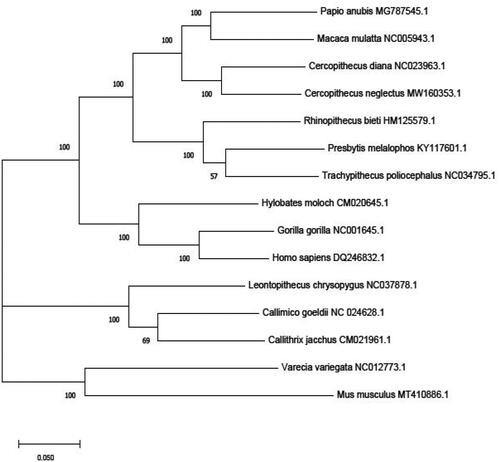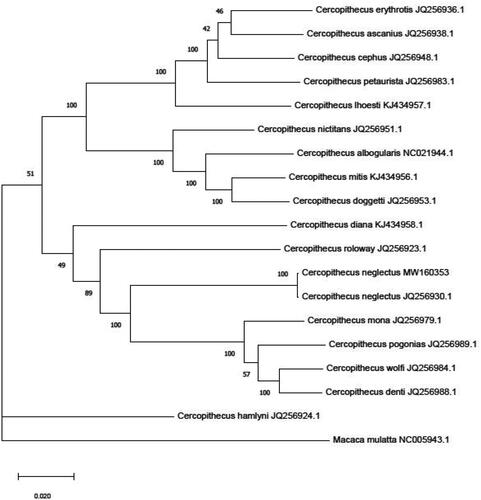Abstract
The complete mitochondrial genome of Cercopithecus neglectus was described. The mitogenome is 16,490 bp in length and consists 13 protein-coding genes (PCGs), 22 transfer-RNA genes, two ribosomal-RNA genes, and one non-coding region. All the 13 PCGs were 11,398 bp in length with most common start codon of ATG and termination codon of TAA. The overall GC content was 42.5%. The result of phylogenetic analysis showed that the relationship of C. neglectus was close to C. mona, C. pogonias, C. wolfi and C. denti.
Background
De Brazza’smonkey (Cercopithecus neglectus Schlegel, 1876) was assessed to be Least Concern (LC) by IUCN (2016) and was listed in Appendix II of CITES. This species distributes widely in Angola, Cameroon, Equatorial Guinea, Gabon, Congo, Central African Republic, Uganda, Kenya, Sudan and Ethiopia (Mwenja et al. Citation2019). Deforestation and habitat loss are dominant factors causing the C. neglectus population to decline (Brennan Citation1985). The classification of the has been a major challenge for primate taxonomists (Groves Citation2001; Butynski Citation2002; Grubb et al. Citation2003),and the phylogenetic status of C. neglectus with other guenons species, should be concentrated. In this study, we sequenced the complete mitochondrial genome of C. neglectus and estimated the phylogenetic status of 17 Cercopithecus species. We hope to provide valuable information for the classification of Cercopithecus species (Ayoola et al. Citation2019).
Materials and methods
The blood sample was collected from a female C. neglectus in Shanghai Zoological Park (longitude-121.36319, latitude-31.192682), Shanghai, China in March 2020. The sampling process was approved by the welfare and ethical committee in Shanghai Zoological Park. A specimen was deposited at the Endangered Species Conservation and Research Center of Shanghai Zoological Park (Liu Qunxiu, [email protected]) under the voucher number SH0008.
Total genomic DNA was extracted from the blood sample by Ezup blood kit (developed by Shanghai Sango Biotech Company, No.B518253). Based on closely related species, degenerate premiers were designed for PCR-amplification. The nucleotide sequences and relative PCR primers are shown in .
Table 1. Sequences of primers used in amplification of the complete mitochondrial genome in C. neglects.
PCR was carried out under the following conditions: (1) 95 °C for 5 min (initial denaturation), (2) 94 °C for 30 sec (denaturation), (3) 58 °C for 30 sec (annealing), (4) 72 °C for 60 sec (extension), and then repeat (2)–(4) 38 cycles and a final extension at 72 °C for 10 min. Amplified PCR products were examined, purified and sequenced on ABI DNA sequencer (3730XL, America). Annotation was carried out by mitochondrial genome annotation (MITOS) (Bernt et al. Citation2013), tRNAscan-SE (Chan and Lowe Citation2019) and GeSeq – Annotation of Organellar Genomes web server (Tillich et al. Citation2017). Base composition was analyzed by MEGA 7.0 (Kumar et al. Citation2016).
The phylogenetic position of C. neglectus was assessed by comparison with the mtDNA sequences of different species from the NCBI database. Evolutionary phylogeny analysis was performed by MEGA 7.0 based on Maximum likelihood (ML) method because ML picks out the topology with the maximum likelihood based on good theoretical basis of statistics (Kumar et al. Citation2016). The phylogeny trees of 14 primates and 17 Cercopithecus species were set up by bootstrap of 500 iterations.
Results
We obtained the complete mtDNA genome of an individual of C. neglectus. The mitogenome was submitted to NCBI GenBank and is available with accession number MW160353.
The complete mitogenome of C. neglectus is 16,490 bp in length. The base composition is A (31.6%), C (29.7%), T (25.8%) and G (12.8%) with 42.5% GC content. The mitogenome is consists of 37 genes [13 protein-coding genes (PCGs), two ribosomal RNAs (rRNA), 22 transfer RNAs (tRNA)]. All tRNAs have the typical cloverleaf structure.
All the 13 protein-coding genes (11,398 bp in length) were predicted by comparing with the previously published monkey mitochondrial genome sequences. We found similar gene arrangement and codon usage with other Cercopithecidae mitochondrial genome (Lei et al. Citation2010; Chang et al. Citation2016). A total of 10 of them use ATG as the start codon, while ND2, ND3 and ND5 use ATC, ATT and ATA separately. For the stop codon, there are ten protein-coding genes terminated with the typical stop condon of TAA, whereas ND1, ND2 and ND6 terminated with TAG, TAG and AGG ().
Table 2. The composition of the mitogenome of C. neglectus.
For primates, C. neglectus was clustered together with Papio Anubis and Macaca mulatta with high bootstrap values (). Among the Cercopithecus species, C. neglectus was close to C. mona, C. pogonias, C. wolfi and C. denti (). In the phylogeny analyses of guenons species, Chatterjee et al. (Citation2009) reported that C. neglectus forms a clade with C. mona, C. hamlyni, C. solatus and several Chlorocebus species. Disotell and Raaum (Citation2004) found that C. neglectus, C. pogonias and C. mona were clustered together. Katerina et al. (Citation2013) inferred the evolutionary relationships of all guenon taxa and reported that C. neglectus was close to C. Diana, C. mona and C. pogonias wolfi (Katerina et al. Citation2013). However, all the analyses on C. neglectus were based on subregion or partial mitochondrial genome sequence. In our study, we determined the first complete mitochondrial genome sequence of C. neglectus and estimated the phylogeny position of C. neglectus with other species. This study will help to better understand the features of C. neglectus mitogenome and provide more potential information for further evolutionary relationships within Cercopithecus.
Figure 1. Phylogenetic relationship of 13 primate species based on Maximum likelihood model. Genbank accession Number: Homo sapiens (DQ246832.1), Gorilla gorilla (NC001645.1), Hylobates moloch (CM020645.1), Varecia variegate variegate (NC012773.1), Presbytis melalophos mitrata (KY117601.1), Rhinopithecus bieti (HM125579.1), Papio anubis (MG787545.1), Macaca mulatta (NC005943.1), Cercopithecus diana (NC023963.1), Leontopithecus chrysopygus (NC037878.1), Callimico goeldii (NC024628.1), Callithrix jacchus (CM021961.1), Trachypithecus poliocephalus (NC034795.1). Mus musculus (MT410886.1) was set as outgroup taxon.

Figure 2. Phylogenetic relationship of 17 species of Cercopithecus based on Maximum likelihood model. Genbank accession number: C. erythrotis (JQ256936.1), C. cephus (JQ256948.1), C. petaurista (JQ256983.1), C. ascanius (JQ256938.1), C. lhoesti (KJ434957.1), C. nictitans (JQ256951.1), C. albogularis (NC021944.1), C. mitis (KJ434956.1), C. doggetti (JQ256953.1), C. hamlyni (JQ256924.1), C. diana (KJ434958.1), C.roloway (JQ256923.1), C. neglectus (MW160353), C. neglectus (JQ256930.1), C. mona (JQ256979.1), C. pogonias (JQ256989.1), C. wolfi (JQ256984) and C. denti (JQ256988.1). Macaca mulatta (NC005943.1) was set as outgroup taxon.

Acknowledgments
We thank the great help of Zhang Qiong from the Animal Breeding and Conservation Department of Shanghai Zoological Park, Gui Jianfeng from Veterinary Hospital of Shanghai Zoological Park.
Disclosure statement
There was no potential conflict of interest in the authors, and the authors alone are responsible for the content of the paper.
Data availability statement
The genome sequence data that support the findings of this study are openly available in GenBank of NCBI at (https://www.ncbi.nlm.nih.gov/) under the accession no. MW160353 and available at: https://www.ncbi.nlm.nih.gov/nuccore/MW160353.1/.
Additional information
Funding
References
- Ayoola AO, Wang Y, Nneji LM, Adeola AC, Ogunjemite BG, Wu D-D. 2019. Complete mitochondrial genome sequence for the Cercopithecus erythrotis camerunensis (Primate: Cercopithecidae). Mitochondrial DNA B. 4(1):209–210.
- Bernt M, Donath A, Jühling F, Externbrink F, Florentz C, Fritzsch G, Pütz J, Middendorf M, Stadler PF. 2013. MITOS: improved de novo metazoan mitochondrial genome annotation. Mol Phylogenet Evol. 69(2):313–319.
- Brennan EJ. 1985. De Brazza's monkeys (Cercopithecus neglectus) in Kenya: census, distribution, and conservation. Am J Primatol. 8(4):269–277.
- Butynski TM. 2002. The guenons: an overview of diversity and taxonomy. In: Glenn ME, Cords M, editors. The guenons: diversity and adaptation in African monkeys. New York, Boston, Dordrecht, London, Moscow: Kluwer Academic/Plenum Publishers; p. 3–13.
- Chan PP, Lowe TM. 2019. tRNAscan-SE: searching for tRNA genes in genomic sequences. Methods Mol Biol. 1962:1–14.
- Chang P, Li Y, Zhang Z, Hwang D. 2016. Complete mitochondrial genome of the sooty mangabey, Cercocebus atys atys (Mammalia: Primates: Cercopithecidae). Mitochondrial DNA A DNA Mapp Seq Anal. 27(6):3897–3893.
- Chatterjee HJ, Ho SY, Barnes I, Groves C. 2009. Estimating the phylogeny and divergence times of primates using a supermatrix approach. BMC Evol Biol. 9(1):259–219.
- Disotell TR, Raaum RL. 2004. Molecular timescale and gene tree incongruence in the guenons. The guenons: diversity and adaptation in African monkeys. New York: Springer US.
- Groves CP. 2001. Primate taxonomy. Washington, DC: Smithsonian Institution Press.
- Grubb P, Butynski TM, Oates JF, Bearder SK, Disotell TR, Groves CP, Struhsaker TT. 2003. An assessment of the diversity of African primates. Int J Primatol. 24(6):1301–1357.
- Katerina G, Krause J, Sawyer S, Valente LM, Bailey S, Finstermeier K, Sabin R, Gilissen E, Sonet G, Nagy ZT, et al. 2013. Next-generation museomics disentangles one of the largest primate radiations. Syst. Biol. 62(4):539–554.
- Kumar S, Stecher G, Tamura K. 2016. MEGA7: molecular evolutionary genetics analysis version 7.0 for bigger datasets. Mol Biol Evol. 33(7):1870–1874.
- Lei R, Shore GD, Brenneman RA, Engberg SE, Sitzmann BD, Bailey CA, Kimmel LM, Randriamampionona R, Ranaivoarisoa JF, Louis EE. 2010. Complete sequence and gene organization of the mitochondrial genome for Hubbard's sportive lemur (Lepilemur hubbardorum). Gene. 464(1–2):44–49.
- Mwenja I, Maisels F, Hart JA. 2019. Cercopithecus neglectus. IUCN Red List Threatened Species. 2019:e.T4223A17947167. https://dx.doi.org/10.2305/IUCN.UK.2019-3.RLTS.T4223A17947167.en.
- Tillich M, Lehwark P, Pellizzer T, Ulbricht-Jones ES, Fischer A, Bock R, Greiner S. 2017. GeSeq - versatile and accurate annotation of organelle genomes . Nucleic Acids Res. 45(W1):W6–W11.
